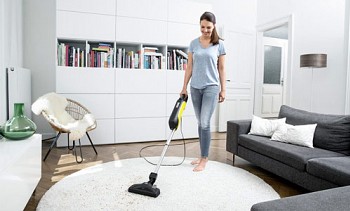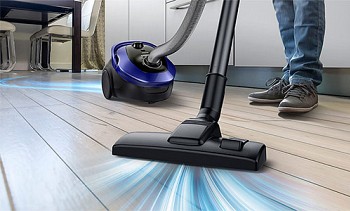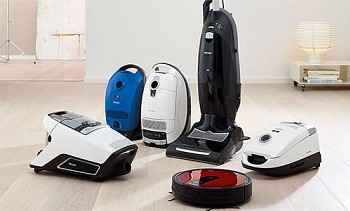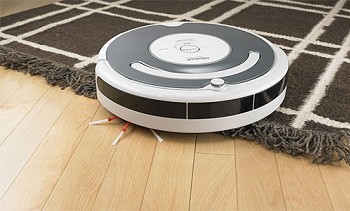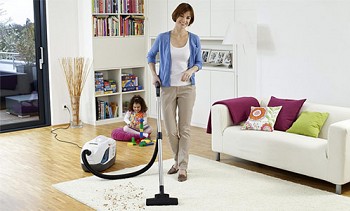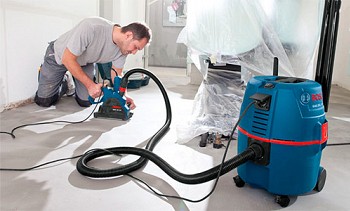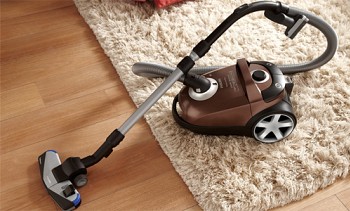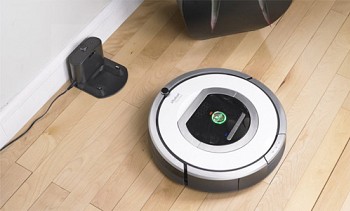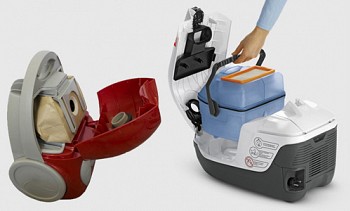Vacuum cleaners of the washing type can not only clean rooms from dust, but also clean floors thoroughly. After all, effective cleaning agents that give a minimum of foam are added to the water for cleaning. And a similar device can easily remove wet debris, which an ordinary vacuum cleaner can not cope with. Impressed with all these advantages, a person is ready to go shopping. Often one thing stops him: he does not know how to choose a washing vacuum cleaner. To help those at the crossroads - this article.

Content:
- Features and operating principle of washing vacuum cleaners
- Suction power and power consumption - it is important not to confuse
- Water tank capacity
- What you need to know about dust filtration systems
- Suction tubes, hoses, control panel
- What nozzles are needed for cleaning
- Weight and dimensions
- Ease of maintenance
- Noise characteristics
- Some more tips
Features and operating principle of washing vacuum cleaners
The principle of operation for all devices equipped with a washing function is the same. They have a special container where clean water and detergent are poured. In spray mode, it flows through the hose to the nozzle under pressure, distributed over its entire surface and wetting the floor. Then, under the influence of rarefied air, collected from the floor surface, the dirty liquid goes through the dirt channels into the second tank for dirty water.

1. Clean detergent solution. 2. Sprayer. 3. Spray the cleaning solution. 4. Suction of dirt. 5. The collected dirt moves to a special container. 6. The direction of movement of the brush.
After the operation of such a vacuum cleaner, the entire floor surface becomes equally clean, there are no spots or stains anywhere. This quality of cleaning can be achieved due to the constant supply of clean water. Washed linoleum, tile and laminate dry almost instantly. After a couple of minutes on the clean floor you can already walk safely. In principle, a hard floor is cleaned clean with a regular mop. But to clean and refresh the carpet, returning it to bright colors, only a washing vacuum cleaner can do.
Such appliances that can clean the floor can be distinguished in a separate class. They, like ordinary vacuum cleaners, are able to dry clean efficiently. However, if necessary, you can always turn on the wet cleaning mode, which allows not only to wash the flooring, but also to collect wet garbage.
When is it convenient to use a washing vacuum cleaner
For daily needs, especially in a small apartment, a washing vacuum cleaner is not very convenient to use. It is quite bulky and requires a lot of storage space, has tangible weight and is not able to drive everywhere. And after cleaning it will have to be disassembled into parts that require washing and drying. There is plenty of time for this, so owners of small rooms should better look at ordinary vacuum cleaners.
But it’s good to use washing units in those apartments or houses where the area for cleaning is large enough. They will also be useful for pet owners - such a vacuum cleaner will famously collect wool, even wet. And for those who prefer to cover the floor with fluffy carpets, it would also be nice to get a similar device. Best of all, he copes with the general cleaning, quickly processing large areas. However, some owners of large apartments are happy to use washing vacuum cleaners even for frequent cleaning.
Ideal coatings for such appliances are ceramic tiles or stone floors. It is also convenient to use them on carpets, where the basis is thin latex. Linoleum and a moisture resistant laminate are two more surfaces suitable for wet processing. But parquet, carpets based on natural jute, carpet with a base of foam materials do not like this treatment.You should also save furniture that is afraid of moisture.
Suction power and power consumption - it is important not to confuse
To ensure that you are satisfied with the quality of the vacuum cleaner, the minimum acceptable suction power of the washing vacuum cleaner is 300 watts. And when you need to remove very quickly, using various filters, you will need an aggregate with a higher suction power - from 400 watts. More is possible - stock will never hurt. Even if the device will rarely turn on at maximum power, but at high loads it will definitely not fail, i.e. there will be a redistributed safety factor. It should be remembered that it is the suction power that is the determining parameter when choosing a vacuum cleaner. Do not confuse it with the power consumption indicated in the passport.
These are the next tricks of marketers: manufacturers of vacuum cleaners, trying to attract customers, operate with numbers in thousands of watts (1000, 2000, 2500). However, here we are talking about power consumption, the increase of which leads to increased energy consumption. And the performance is affected by the suction power. She at the best washing vacuum cleaner reaches only 900 watts. At the same time, it can consume much less electricity than cheap Chinese models, supposedly “super powerful”.
The characteristics can indicate both the average (nominal) and the maximum value of the consumed power and suction power. The maximum exceeds the nominal value of percent by 15-30. Usually, it can be achieved only when the vacuum cleaner is turned on, and even then, if the working conditions are ideal. Therefore, it is better to focus on average power. When deciding in a store which washing vacuum cleaner to choose, compare the average and maximum power values of the models you like. This will help determine the specific choice.
Water tank capacity
This is perhaps one of the most important details that you need to pay attention to when choosing a device. If your house has one or two rooms, then you can safely take a model with a tank of 2 to 4 liters. A three-room apartment will require a larger tank - from 4 to 5 liters. A large house with a large area will be conveniently cleaned with a washing vacuum cleaner with a tank of 8 to 10 liters. Otherwise, you will have to constantly run for water, changing it. This is pretty annoying - after all, when replacing water, the vacuum cleaner needs to be disassembled every time. It’s better to immediately buy a model with parameters corresponding to the cleaned area.
We did not mention the second tank, which collects dirty water. The fact is that its volume when choosing a vacuum cleaner is not necessary. As a rule, it depends on the volume of the tank for clean water.
What you need to know about dust filtration systems
Once in the tank with water, the mousse is moistened, heavier and settles at the bottom. But not all - from 5 to 10% of light dust particles safely avoid this fate. Air bubbles rescue them, inside which they appear. Emerging with these bubbles to the surface, fine dust remains dry and unharmed. But ahead of her are fine filters (the same as in dry-type vacuum cleaners). These are usually AFS, S or HEPA filters. They deal best with the task of a device with aquafilters.
They perfectly capture large particles of dirt and dust that sink in the water. Thanks to this, the air that enters the room is cleaned. However, even the aqua-filter is not omnipotent - and it passes from 1.5 to 2% fine dust. Charcoal HEPA and S fine filters help her to “catch”. They serve at least a year (some models - several years) and require only periodic washing under running water. According to EN 1822, the HEPA filters used capture 99.5% of particles from 6 microns in size. S filters in accordance with DIN 24184 remove dust particles from 3 microns in size - this is 99.7% of contaminants.
Let us consider in more detail the classes of HEPA filters, the effectiveness of which is usually determined according to the norm of EN 1822.
The following filters are available:
| Filter Name and Labeling | The percentage of particles removed,% |
|---|---|
| HEPA H 10 | 85 |
| HEPA H 11 | 95 |
| HEPA N 12 | 99,5 |
| HEPA H 13 | 99,95 |
| HEPA H 14 | 99,995 |
| HEPA (ULPA) H 15 | 99,9995 |
| HEPA (ULPA) H 16 | 99,99995 |
A number of models of washing vacuum cleaners in the design have a separator that can trap small particles of dust. After all, as we remember, they "hide" in air bubbles. The separator corrects this drawback - when it rotates quickly, a shallow water suspension forms, retaining even microscopic dust particles. Air purification efficiency increases to 99.97%.
Before buying the model you are interested in, be sure to ask what filtering system is installed there, especially for people suffering from allergies.
Suction tubes, hoses, control panel
Modern vacuum cleaners are equipped with telescopic tubes. They are convenient in that they are easily adjustable, therefore suitable for a person of any height.
The "advanced" models have a control panel on the handle, it is very convenient.

According to the method of connecting with the electronics of the vacuum cleaner itself, they are of three types:
Method 1 - management of wire type. Wires are routed inside the hose, connecting the vacuum cleaner and its handle. This is the most budget option, it is used quite often. He has a negative point - the wires noticeably make the hose heavier.
Method 2 - infrared control. Here, the principle of operation is the same as that of a remote television remote control. No wires, just insert two batteries into the remote. But sometimes the signal does not reach the vacuum cleaner, lingering on an obstacle. It can be, for example, a sofa or a wardrobe.
Method 3 - radio control. This method is convenient, efficient and error-free. It is tempting to choose a washing vacuum cleaner for your home on a radio control, but there are still very few models of this type. And they are expensive.
Vacuum cleaner tubes can be made of steel, aluminum or plastic. The latter are cheaper than the rest, but they are not so durable. The most reliable and strongest are steel tubes. It is very convenient to use telescopic-type collapsible tubes, but they have a significant drawback: gradually loose joints begin to pass water. You can, of course, use long solid tubes, but they are not very convenient to use.
What nozzles are needed for cleaning
Typically, a vacuum cleaner in a set of such nozzles from five to seven. This is a device for dry cleaning, having the “floor” and “carpet” modes, as well as nozzles for washing the floor, for cleaning furniture, processing glass. Sometimes there is a plunger.

Wet cleaning is usually done with the main nozzle designed for cleaning carpets. To wash the hard flooring, a special adapter is put on it. Even for wet cleaning use a nozzle for cleaning upholstered furniture and small planes, as well as a brush for hard surfaces.
Dry cleaning involves the presence of a universal brush, in which the pile height can be adjusted. It is suitable for any type of surface. A small brush will allow you to reach hard-to-reach places, and with a crevice nozzle they clean the furniture.
In general, the choice of nozzles and accessories is very large, but it all depends on the manufacturers. Each of them, competing with each other, creates their own adaptations or improve old ones. There is no way to describe them all, but some of them are worth paying attention to.
VAX supplies its vacuum cleaners with a special anti-static brush, which is convenient to clean a computer monitor, keyboard, or television screen. And the plunger nozzle will help the THOMAS vacuum cleaner even quickly clean the sink. Convenient appliances are manufactured by ROWENTA. So, the Swip brush nozzle easily removes dust from the louvres of the blinds and the keyboard, and the Wip nozzle, made of soft foam, does not damage the polished furniture or TV screen. This manufacturer also took care of the carpets with upholstered furniture, having prepared a turbo brush for them.
The nozzle for hard coatings has a special brush strip that can be used to mop up dirty floors. Working with it is reminiscent of washing the floor with a mop, but it turns out more efficiently.After all, clean water is constantly supplied, and dirty water is sucked into a special tank. Here you should praise the nozzle from the PHILIPS company, which will clean the dirt that has dried up on the floor, and thoroughly wash the floor at a time, and collect all the dirty water to a drop. At the same time, it has a very economical consumption of clean water.
If you need to wash window panes, window nozzles made by ROWENTA and PHILIPS are useful. The companies DELONGHI and LG went the other way - for this case they produce nozzle-rollers. On the one hand, they have a sponge that moistens the glass, and on the other, a rubber scraper that removes dirt. In this way, you can wash mirrors and various ceramic coatings.
Weight and dimensions
To decide which vacuum cleaner to choose for a house or apartment, you need to navigate in the sizes of different models. The washing units are horizontal and vertical. The last option is a classic. Such models are produced by ROWENTA, DELONGHI, THOMAS, VAX. And the very first washing vacuum cleaner was exactly vertical. This device looks a bit like a bucket equipped with automatic control. Its body looks like a cylinder or trapezoid, and an engine is located above the water tanks. A cylindrical vacuum cleaner is heavier and larger, its water tanks are more capacious. Such devices are used by professionals, they are suitable for a large apartment or house.

If you do not like the bulky vertical model (or maybe there’s simply nowhere to put it), then you can purchase a more compact vacuum cleaner. Outwardly, he is very similar to his younger brother - a device for dry cleaning. Its elegant design fits well with the style of modern apartments, and its good maneuverability allows it to be used even in small rooms.

Ease of maintenance
Each time after work, the washing vacuum cleaner must be disassembled and washed, so manufacturers are striving to make assembly and disassembly simple and quick. If everything is arranged rationally and correctly, then this process will not take more than 15 minutes. And those models in which the parts are located inconveniently have to disassemble and assemble for a long time.
A lot in this regard depends on the location of the water tanks. For example, VAX has a clean water tank on top and a waste liquid tank underneath. To drain it, you need to remove the upper tank - it is long and not too convenient.

But the often used design "tank in tank" is quite simple to use. Here, the lower part of the housing also serves as a container for dirty water. She has inside a removable tank with water and shampoo for cleaning. To refuel it, you need to open the side latches and remove the tank. THOMAS and KARCHER produce vertical models in this version.

ROWENTA has developed a slightly different design - a one-piece tank consisting of two cylinders inserted one into the other. The inner cylinder for clean water can be filled several times, and then pour dirty water. With a large amount of work, this is very convenient. And if you have to clean a small room, one serving of clean water and shampoo is enough.
Noise characteristics
Washing units are no more “loud” than ordinary vacuum cleaners. If the device is made in good faith, and its details are of high quality, then it will not make much noise. Models of well-known brands have a noise level not higher than 60-65 decibels. This figure is less than that of a washing machine. However, the short-term operation of vacuum cleaners makes their noise level not so significant parameter.
Some more tips
Tip 1.
Calculate the range of the unit by adding the length of the hose, tube with a brush, cord and body. It should turn out at least 7 meters. Automatic cord reeling is a necessary function. Too abrupt reeling is unacceptable - it is fraught with injuries.


Tip 2.
The engine must have auto shut off when overheating. Overload protection is also needed - in many models, a soft start function serves for this.
Tip 3.
Vacuum cleaners of a washing type can make a house much cleaner. It is especially useful to use them where allergies and pulmonary patients live.

Now, having studied the theory, you know how to choose a washing vacuum cleaner according to technical characteristics and their needs. You can safely proceed to practice.

